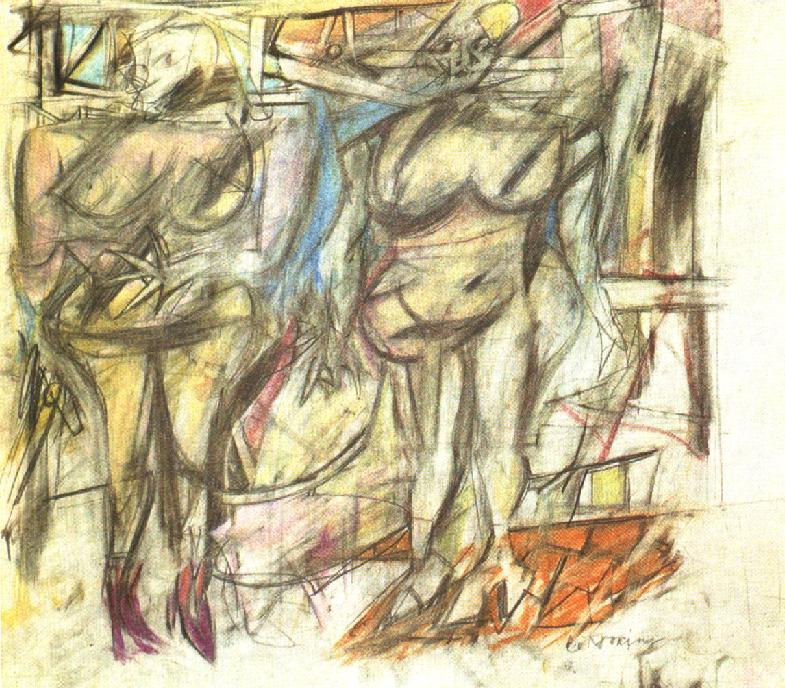Tuesday, July 3, 2012
Willem de Kooning's Drawings of Women
Willem de Kooning: Tracing the Figure, a comprehensive survey of the artist's drawings on paper depicting the female form, was on view in the East Building of the National Gallery of Art, from September 29, 2002, through January 5, 2003. Widely regarded as one of the great pioneers of abstract expressionism, de Kooning is known for the vividly abstract figure-based paintings and drawings that placed him at the center of the New York School. The exhibition featured 66 works produced between 1938 and 1955.
In Willem de Kooning: Tracing the Figure, the assembled works on paper, organized around themes found in the critical early years of de Kooning's exploration of the female figure, illustrated the artist's struggle to eliminate traditional barriers between drawing and painting. Ranging from his early surrealist-inspired portraits of Elaine de Kooning and Juliette Brauner in 1938, to the drawings of 1955, when the figure dissipates into abstraction, the works incorporated a variety of media, including graphite, charcoal, pastels, and oil on paper.
The exhibition highlighted key pastels from 1952-1953 that were the centerpiece of de Kooning's 1953 exhibition at the Sidney Janis Gallery, in New York. Many of the original 16 works on paper were exhibited together for the first time since that groundbreaking exhibition. To many, this group of pastels and charcoals represents the pinnacle of de Kooning's examination of the female form.
His first series of women, approximately 1938-1944, revealed the influences of his formal training and highlighted thematic dualities such as tradition and modernism, geometry and automatism, figuration and abstraction. Between 1945 and 1946, de Kooning's semi-abstract works, which included color and collage elements, contributed to an increasingly noticeable tension between flatness and an illusion of depth. It is during this period that the double figure drawings began to emerge.
As de Kooning's figural compositions developed, geometric configurations were transformed into architectural elements, as in Two Women (1952).
In 1951, de Kooning suspended his simultaneous work on abstract and figurative forms and returned to depictions of women. The anatomy of these women disintegrates into a cross layering of brushwork. The effect created by the size and intentional vulgarity of the images establish an almost violent sensuality--an exaggeration of gender parallel to the ubiquitous calendar girl of the time. But de Kooning's turbulent gestural style belies the artist's meticulous re-working of his paintings and drawings.
ABOUT THE ARTIST
Willem de Kooning was born April 24, 1904, in Rotterdam, Holland. Following formal studies in fine and applied art at the Rotterdam Academy, he emigrated to America at age 22. In New York he initially supported himself as a house painter and commercial artist. During the late 1920s and 1930s he developed friendships with fellow painters Stuart Davis, John Graham, and Arshile Gorky, and painted murals for the Federal Arts Project before devoting himself full-time to a career as an artist in 1936.
He is best known for a provocative series of paintings of women, whose aggressive forms are rendered with slashing strokes and dripping paint. Throughout his long and prolific career, his painting oscillated between the figurative and the purely abstract, eventually dissolving anatomy into abstraction. His work places him in the tradition of figurative artists such as Eugène Delacroix, Jean-Auguste-Dominique Ingres, Paul Cézanne, and Pablo Picasso. His first retrospective exhibition came in 1968 at the Stedelijk Museum, Amsterdam. In 1985, the artist received the National Medal of Arts in the United States. De Kooning died March 19, 1997, on Long Island.
On Display
Seated Woman, 1940
pencil drawing of Elaine De Kooning, 1940
Untitled, 1947
Pink Lady (Study), ca. 1948
Woman,1951
Two Women with Still Life, 1952
Woman, II, 1952
CURATORS
Willem de Kooning: Tracing the Figure, has been organized by The Museum of Contemporary Art, Los Angeles.
CATALOGUE
The exhibition is accompanied by a comprehensive catalogue copublished by MOCA and Princeton University Press. Willem de Kooning: Tracing the Figure features 85 color plates and essays by MOCA chief curator Paul Schimmel and MOCA curator Cornelia Butler, who both served as the exhibition’s co-curators, as well as leading art historians Anne Wagner and Richard Shiff. Additional support for the exhibition catalogue has been provided by the Frederick R. Weisman Art Foundation.








